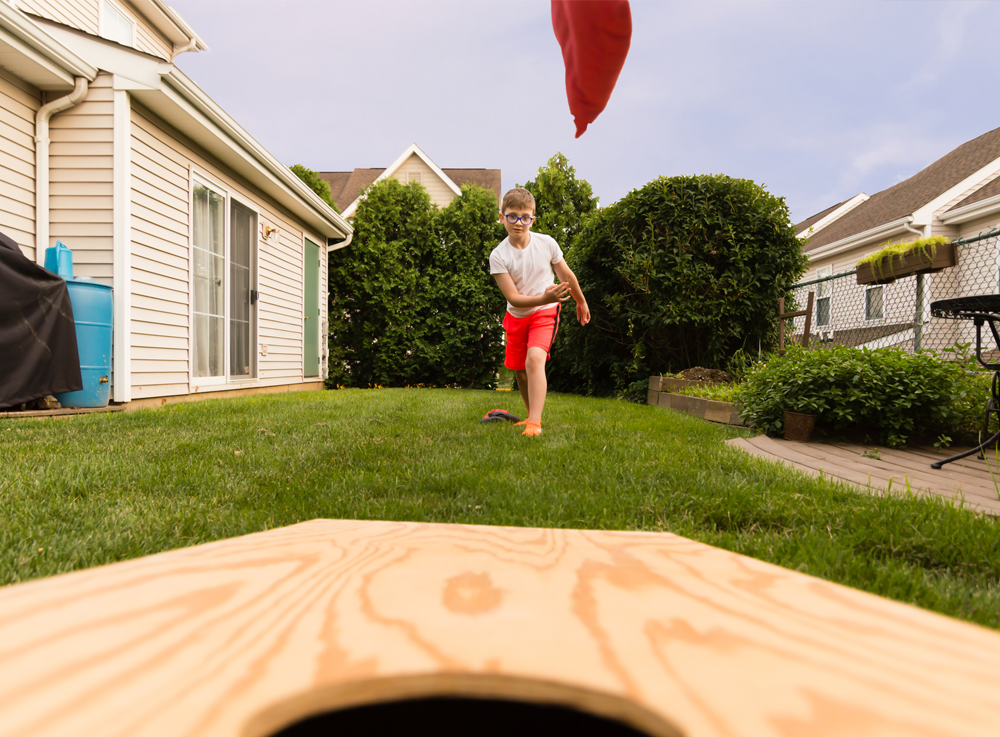
Tired of the air hockey game on your multi-game table? Looking for something quite different from your typical hook and ring toss game?
How about a game of cornhole? It’s fun, exciting, challenging, and works for everyone. In fact, it has become a staple at most outdoor social events. If this sounds interesting to you, here’s a comprehensive guide on everything you need to know about cornhole.
For instance, the regulation cornhole distance is 27 feet edge to edge, and 15 feet for juniors.
We’ll talk about much more than that, starting with what cornhole is, how it’s played, what the rules are, where the game originated, and a few of the best cornhole sets you can buy online.
What is cornhole?
First things first: what is cornhole, exactly?
Simply put, cornhole is a popular American lawn game in which two or four players take turns to toss 16-ounce fabric bags filled with corn kernels (or other fillings) towards a raised, inclined platform, typically made of wood, with a target at the upper center near the far end of the board.
Depending on where the bag lands, the player or team scores a designated number of points, and whoever reaches 21 points first wins the inning. It’s a fun and popular game often played in family outings, tailgating, and professional tournaments.
We’ll talk more about the cornholes rules, scoring, and other must-know facts below.
Cornhole Rules
Generally speaking, cornhole rules are mostly straightforward, especially when you follow the guidelines set by the American Cornhole Association (ACA) on how to play cornhole since they are the most renowned governing body on cornhole tournaments.
These guidelines will help you best enjoy the cornhole game, whether you’re playing a professional round of bean bag toss or doing it just for fun.
Alternatively, you can also check the guidelines, rules, and regulations set by other regulating bodies such as the American Cornhole Organization or the American Cornhole League.
Board Dimensions
Conrhole board dimensions are specifically set for an optimized play. For an acceptable size cornhole board, the dimensions should be:
Cornhole Board Dimensions:
- Length: 47.5 to 48 inches
- Width: 23.5 to 24 inches
- Thickness: minimum of 0.5 inches for the central rectangle
- Elevation: 3 to 4 inches (front edge), 12 inches (back edge)
- Tilt: 8 to 9 inches from the ground (front to back edge)
Cornhole Hole Size:
- Diameter: 6 inches
- Position: 9 inches from the back edge, 12 inches from the side edges
Cornhole Distance
As for the cornhole board distance, this should be properly set up so that the playing field is also optimized. So, how far apart are cornhole boards, as stated by the regulations?
The proper/ official distance between cornhole boards should be:
- Professional: 27 feet from the front edge of one board to the other
- Juniors: 15 feet front-edge cornhole board spacing
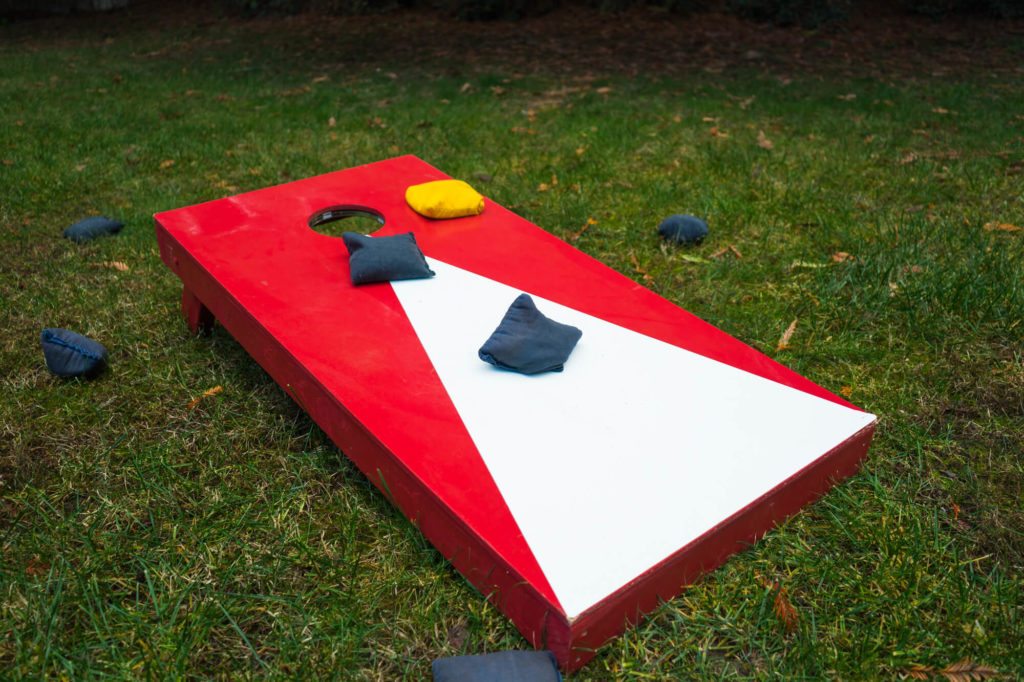
Cornhole Bags
For any game of cornhole, no matter what rules you’re following, there should always be eight bags to make a complete set- two colors with four bags per color. These bags also come with very specific guidelines in terms of size, weight, filling, material, and stitching. Here’s what you should know about cornhole bags:
- Cornhole bag material: square cut fabric
- Fabric measurements: 6.25-inch length on all sides with 0.25-inch seam stitching
- Cornhole bag size: 6 inches tall x 6 inches wide x 1 inch thick
- Cornhole bag weight: 14 to 16 ounces per bag
- Cornhole bag filling: 2 cups feed corn or synthetic plastic pellets
Sand and other materials can also be used as a filling, but corn and pellets are the best materials as per regulations. The fabric can also be treated with certain compounds for weather resistance and anti-skid capabilities.
You can also make your own DIY cornhole bags as long as you follow the specifications and have basic stitching skills.
Corn Filled vs All Weather Bags
Like we mentioned just now, there are many other materials you can use as filling especially to make an all-weather cornhole bag. When deciding which type of cornhole bag you prefer, consider these things. First, corn filled bags feel more genuine and true to the game. After all, it’s in the name itself. These also come with many advantages.
The fine dust from the battered kernels gives the bags a certain chalky quality that makes the bags easier to grip and enables them to slide better on the cornhole board. However, corn filled bags need to be stored indoors and can only be played with under fair weather. And even so, they still have a relatively short service life.
On the other hand, since all-weather cornhole bags are filled with synthetic and inorganic materials such as plastics and fine sand, they last much longer than decaying corn. These bags can also be stored anywhere, and are fine to get wet. That said, you won’t get that “authentic feel” and natural slide that corn filled bags offer.
Board Surface Material
As for the surface material of cornhole boards, only real wood is used in sanctioned cornhole tournaments, since all other materials cannot perform as well as wood. For instance, cornhole bags cannot slide as smoothly on plastic and other surfaces.
This isn’t an issue with finished wood. And speaking of, the wooden cornhole should have a smooth texture with zero blemishes through thorough sanding and finishing in order to make for a consistent playing surface.
There may also be a top coat of semi-gloss latex paint on the board’s exterior to allow for more slide, but never high-gloss as this will prevent the bags from stopping on the playing surface.
Pitcher’s Box
Each player should have a designated pitcher’s box to throw his cornhole bags from. This should be a 4 by 3 feet rectangle located parallel to both cornhole boards on either side.
Foul Lines
There should also be foul lines to serve as each cornhole board’s front edge extension. Each foul line must be 27 feet apart and parallel to the opposite board’s front edge (or 12 to 15 feet for juniors). For a better and fairer play, it should be clearly marked on the playing surface.
Cornhole Procedure and Scoring
After setting up the cornhole set, from the board to the field and equipment, let us now talk about how to play the corn hole game itself- both procedure and scoring.
Every match can be divided into multiple innings of play, with each inning defined by when each player throws all of their four bags. The game can be played with either two players in a 1 vs 1 match, or four players in a 2 vs 2 matches.
Game Procedure – Singles
For a 1 vs 1 game, each player must stay in their own lane throughout the duration of each match, unless multiple matches will be played, in which case the players should alternate lanes for each succeeding match.
Each player starts at the same board and must alternate pitching their respective cornhole bags towards the opposite cornhole board without stepping outside of the foul line. This goes on until both players have no bags left.
Afterward, the inning is concluded and the players should proceed to the opposite side of the cornhole court for score tallying and computing of the total match score. Then, once scoring is done, the second inning starts with the players pitching to the other board, and the game continues until one player first accumulates the winning cornhole points.
Game Procedure – Doubles
For a 2 vs 2 games, the procedures are quite similar to the singles version, save for the following:
Teammates must stand next to their opponents in such that they should be on opposite boards from each other. The game can be started on either side, with each player on that side alternating pitching their bags until all four are pitched.
Moreover, the scoring and tallying are done by the players from the opposite boards, until it’s their turn to pitch back towards the opposite board.
Scoring
As for the scoring, this is accomplished under a net basis.
All scoring in cornhole is done on a net score or cancellation basis. What this means is, only one team can score within each inning. For instance, if team A pitches 6 points in a single inning, while team B pitches 4 points for the same inning, team A wins by 2 points.
The points are assigned as follows:
- 1 point (Woody)- the cornhole bag is resting near the top of the board
- 3 points (Cornhole)- the bag is successfully thrown into the hole, whether through the player’s toss or by hitting another bag already on the board
- 0 points (Foul)- the bag does not land on the board or in the hole
- *Cornhole rules violations can also result in foul bags
Game Length
For a professional game, each inning is concluded once a player or team accumulates at least 21 points. For casual plays, on the other hand, it can be any predetermined number.
A fun variation is to penalize a team that accidentally goes above 21 points by deducting a few marks from their total. For example, if team A has 20 points but scores a 3-pointer, their score goes down to 15, since the goal is to hit exactly 21 points.
Pitching Rotation
For the first inning, the first pitcher can be determined in any fashion, such as a coin toss, a round of rock, paper, and scissors, or assigning to whoever is the lower seeded team. But for the following innings, the player or team who scored from the previous one gets to pitch first.
Player Position
Again, the player must stay inside the pitcher’s box and behind the foul line at all times, including when pitching each of his cornhole bags. The bags must also be tossed underhanded rather than overhand or through a sidearm toss.
Rule Violations
Apart from everything we already discussed above, there are a few other cornhole rules, and not following these rules can result in a rule violation, which translates to a foul bag, aka zero points regardless of the result of your pitch.
Any foul bag that lands on the cornhole board or inside the hole must also be removed before pitching again as foul bags cannot be used to score points.
Here are the following rule violations that you should be mindful of:
- Stepping outside the pitcher’s box or over the foul line while the pitched cornhole bag is still in the air
- Pitching a cornhole bag from the other player’s pitcher’s box
- Any cornhole bag that bounces on the ground or court before landing on the board
- Any cornhole bag that hits people, or foreign objects not a part of the game
- Removing a cornhole bag from the board before the score for the said bag is agreed upon by all parties, in which case the offending team or player must forfeit all their remaining bags for the current inning, while the non-offending team may throw four holes in order to tally 12 points
Other important rules include what counts as a pitched bag, wherein:
- Bags that are accidentally dropped during the backswing/ before the forward motion of the pitch are not considered as pitched bags (meaning you can try again), but
- Bags that are accidentally dropped during the forward motion, for whatever reason, count as pitched bags
Playing Tips
Finally, here are some proven and tested tips and tricks on how to play- and win- a game of cornhole, whether you’re playing casually or at a competition:
- Prepare your mind and body for the pitch by clearing your mind and relaxing your body so you’re not distracted, uptight, or stiff.
- It’s all about muscle memory. If something works, don’t change it, aka keep your stance and pitch consistently. It should be simple and easily reenactable. Use your dominant hand and make sure that your arm motion is smooth like a pendulum.
- Make your pitch similar to throwing a frisbee in the sense that the toss is flat but with a bit of spin, so it has a consistent flight rather than going into unpredictable bounces, which is what happens with an end over end toss. In other words, throw it in the usual underhanded manner, but with the added spin of a frisbee.
- Don’t specifically aim for the hole. This is because the hole is too small and too high that if you miss (and there’s a huge chance you will), the bag will likely fly over the edge of the board rather than landing somewhere on it, leaving you with zero points.
- Rather, go for anywhere on the board, specifically on the front part, so your chances to score will increase. This can either happen with the bag staying put on the board or better yet, sliding up and into the hole.
- The only time you should try for the hole is when opponent bags are surrounding the hole, in which case it’s a make-it-or-break-it situation. Doing an airmail shot to land the bag into the hole might work if you exert a bit of extra loft on the pitch while ensuring that you are directly following through at the target.
6 Best Cornhole Board Sets To Buy In 2021
Ready to play the game? Here are the best cornhole board sets you can buy in 2021:
Tailgating Pros American Flag Wooden Plank Design Cornhole Board Set
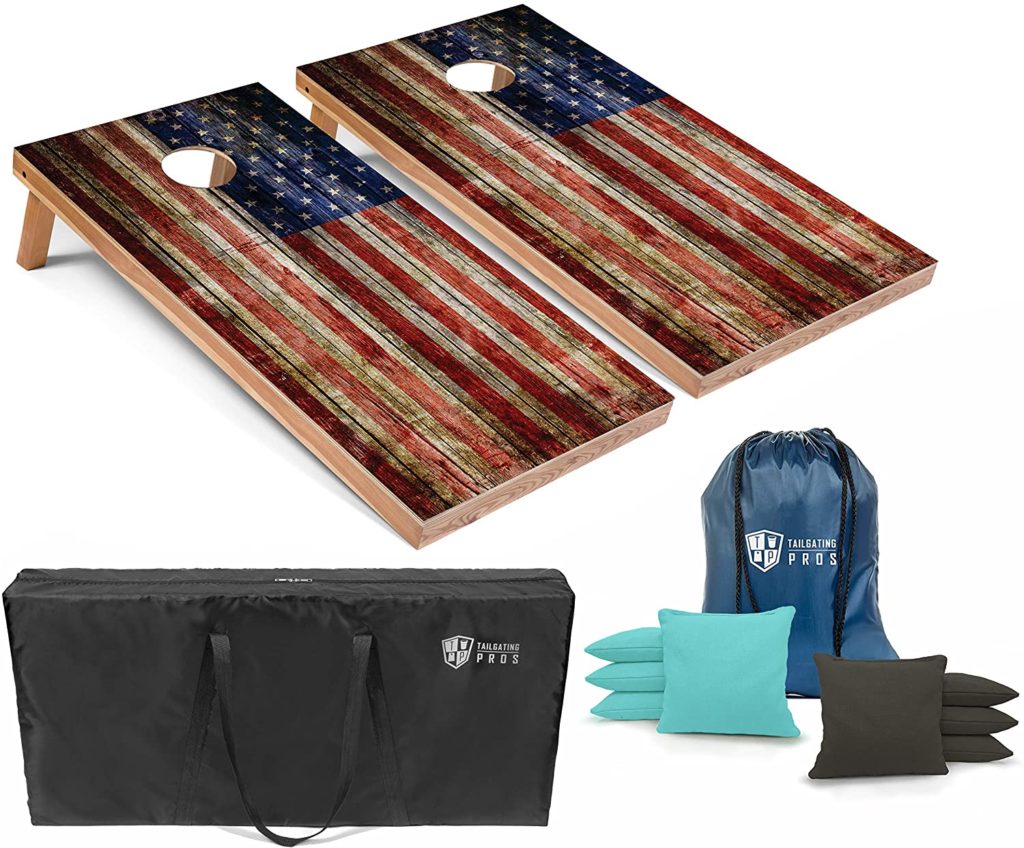
Our top pick is the American Flag style cornhole board set by Tailgating Pros. It’s a regulation sized board that boasts of premium solid wood construction for the frame, along with a half inch top board that connects to the frame through heavy duty hardware and mitered joints.
This board comes with a support bar for bounce prevention, and features that signature flag image that’s directly printed on the wood so it lasts for a long time without peeling. And, its advanced design and lightweight construction makes it convenient and easy to transport.
Moreover, it comes with different colored bean bags (all regulation size) made with double stitched, heavy duty duck canvas and filled with whole corn kernels. A carrying case is included as well for your convenience.
- 4×2’ 100% solid wood board
- 8pcs 6×6” cornhole bags
- Meets ACA regulation standards
- Durable and long lasting
- 1 year free replacement guarantee
GoSports Solid Wood Premium Cornhole Set
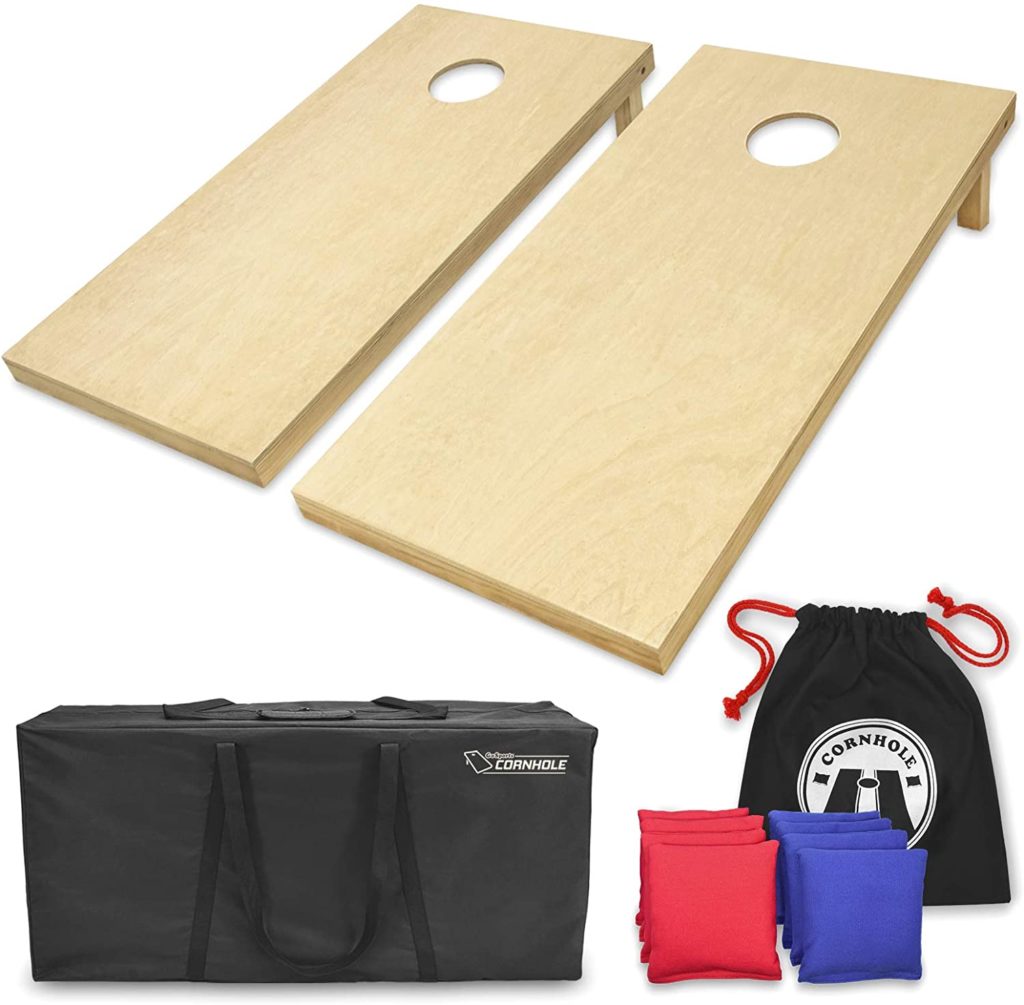
We also really like the GoSports solid wood premium cornhole set, a quality set that’s ideal for your law or backyard with its premium wood construction that really pays tribute to the classic fun of this bean bag toss game.
The solid premium pine wood is free of any plastic or composite materials. It’s rustic, wonderfully designed, varnished, and easy to customize to your preferences. It also comes in a regulation 4×2’ size or a kids 3×2’ size.
Of course, you can always choose to use the board as is. After all, it looks great without any additional decals, and can be the perfect highlight of any family event, game night, tailgating, weekend BBQs, campsites, and so on.
- 4×2’ or 3×2’ authentic wood board
- 8pcs regulation all-weather bean bags
- Easily customizable board surface
- Comes with tote, carrying case, and rules
GoSports Classic Cornhole Set
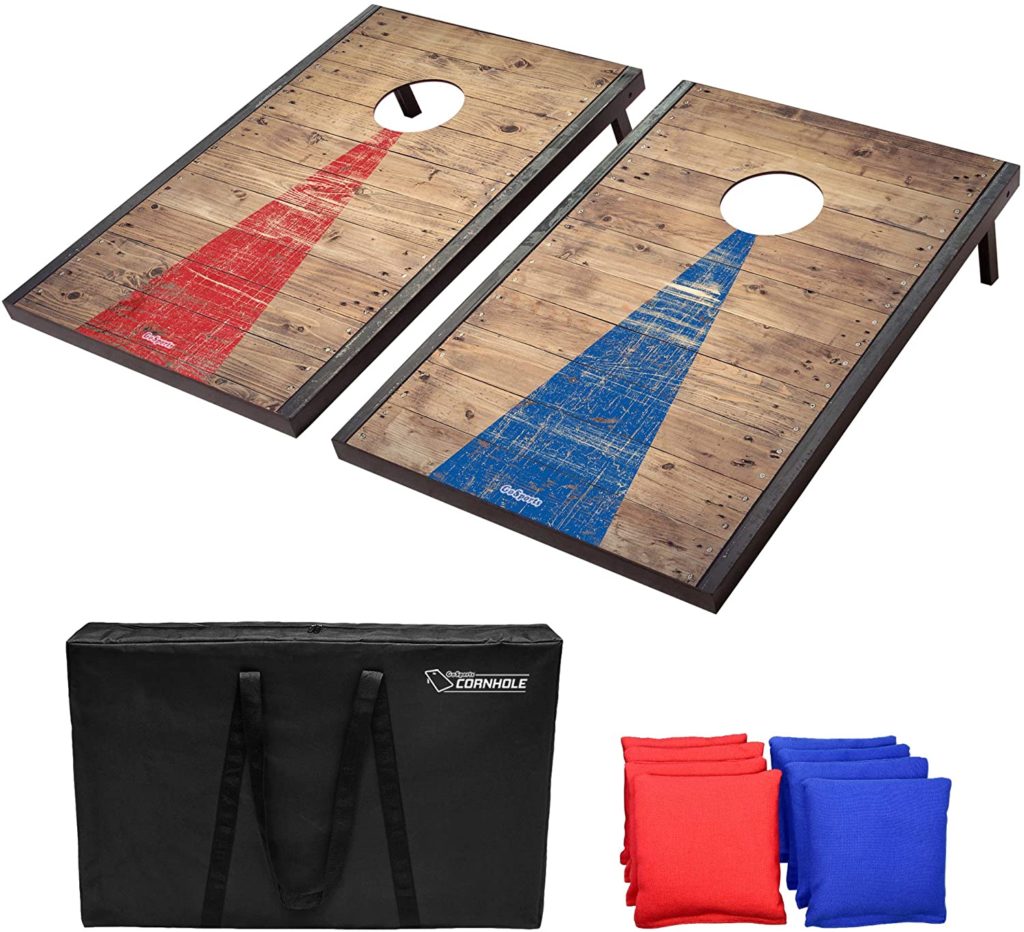
Another amazing option is the GoSports Classic cornhole set, which really gives you the best value for your money. For one, it features MDF constructed boards that provide a nice, solid surface for a superb cornhole experience.
The board can also be purchased in a regulation or tailgate size depending on your preferences. Either way, a robust carry case is included so you can easily transport the game set. The entire thing is also easy to set up within seconds so you can play immediately.
Furthermore, it comes with eight all-weather cornhole bags in red and blue, along with printed game rules. All in all, it’s a great way to spend fun and energizing quality time with your family and friends over the summer.
- 4×2’ or 3×2’ MDF board
- 8pcs all-weather 14oz bean bags
- Rustic vintage board design
- Available in various design options
Viva Sol 2’x4′ Cornhole Set
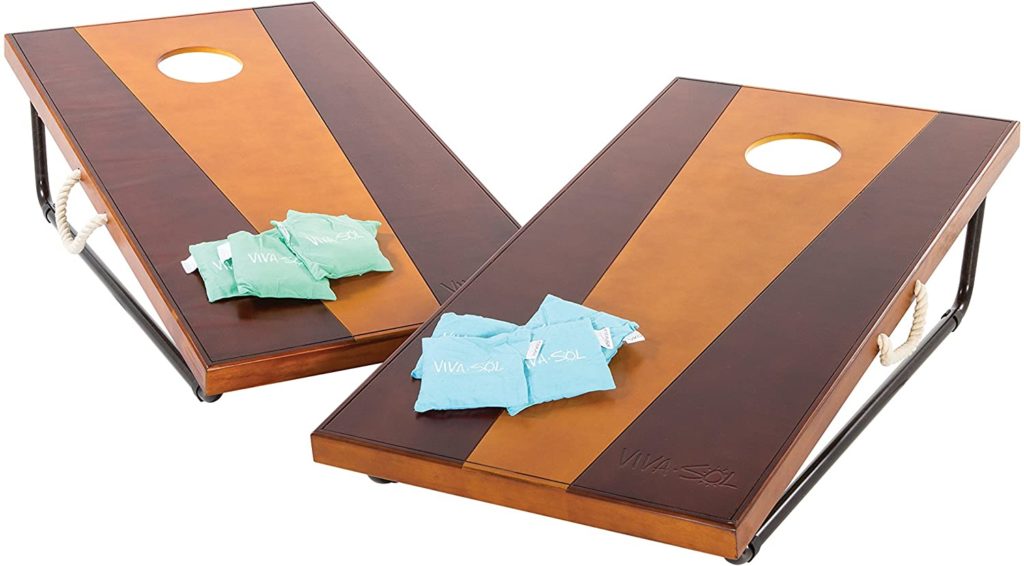
You should also check out the Viva Sol cornhole set, which offers a fun way to make memorable experiences outdoors with your loved ones by giving you a game set that combines a great balance of gamesmanship and craftsmanship.
This game board is made from 100% solid pine wood for the frame, along with high quality steel for reinforcements, so it’s durable, reliable, and will surely last for a long time. It even features a popular finish in veneer and walnut.
Aside from the beautifully designed board surface, what’s underneath is just as commendable, as this cornhole set boasts of all-metal legs that are equal parts stylish and stable. It’s also compact and portable for easy transport and storage.
- 4×2’ regulation wood board
- 8pcs all-weather canvas bags
- Nesting board and folding legs for portability
- With heavy-duty rope handle
Himal Collapsible Portable Corn Hole Boards
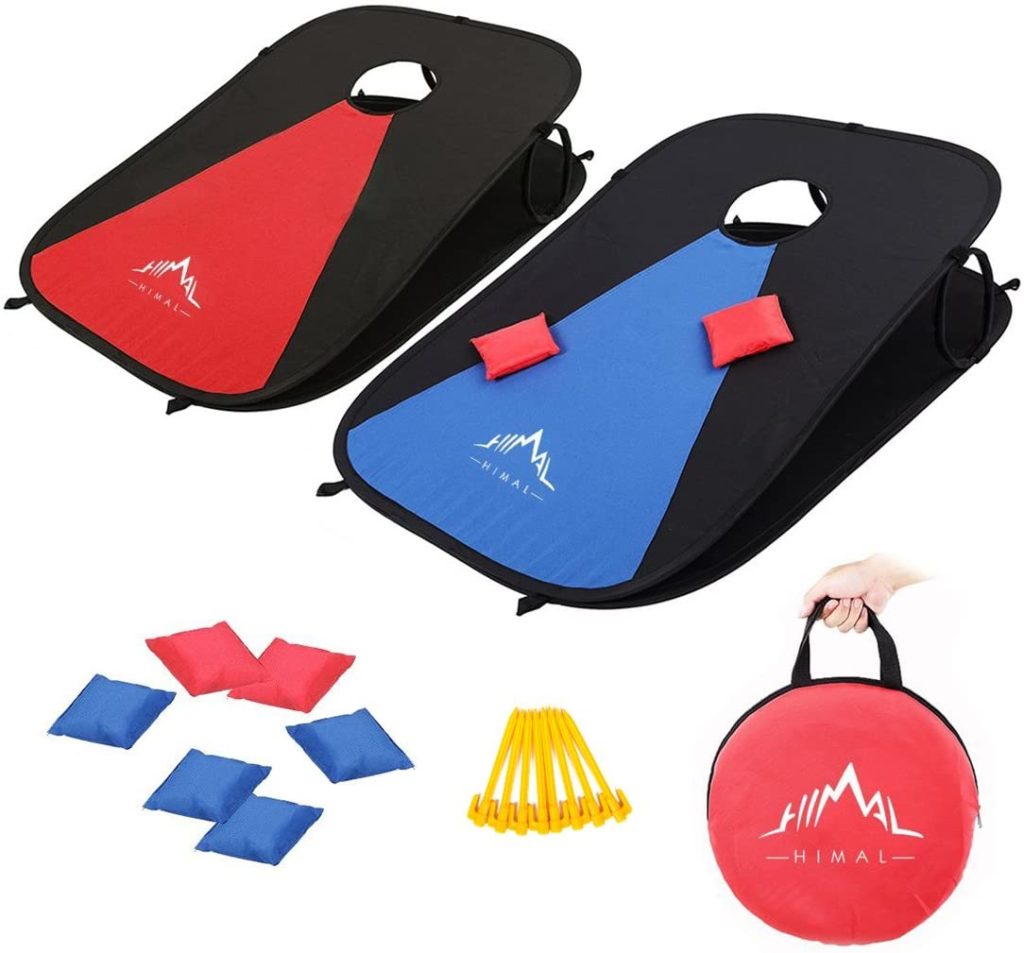
Taking the fifth spot is the Himal collapsible and portable cornhole board, which boasts of an innovative design that lets you easily and quickly assemble the game with a simple flick and stick. Dismantling is also just as easy.
What we really like about this board is its small footprint that makes it highly portable and great for traveling, so you can always have a cornhole game ready. In fact, the entire set weighs just two kilos, and packs into a tiny less-than-a-foot package.
This set is also unique in the sense that it features elements made with highly elastic flat wire that can be folded over a thousand times. Even the poly fabric construction of the bags are durable and skid free thanks to the anti-skid treatment.
- 3×2’ tailgate size board
- 8pcs cornhole bean bags
- Foldable and stackable design
- Free warranty for Himal Care members
SPORT BEATS Cornhole Bags
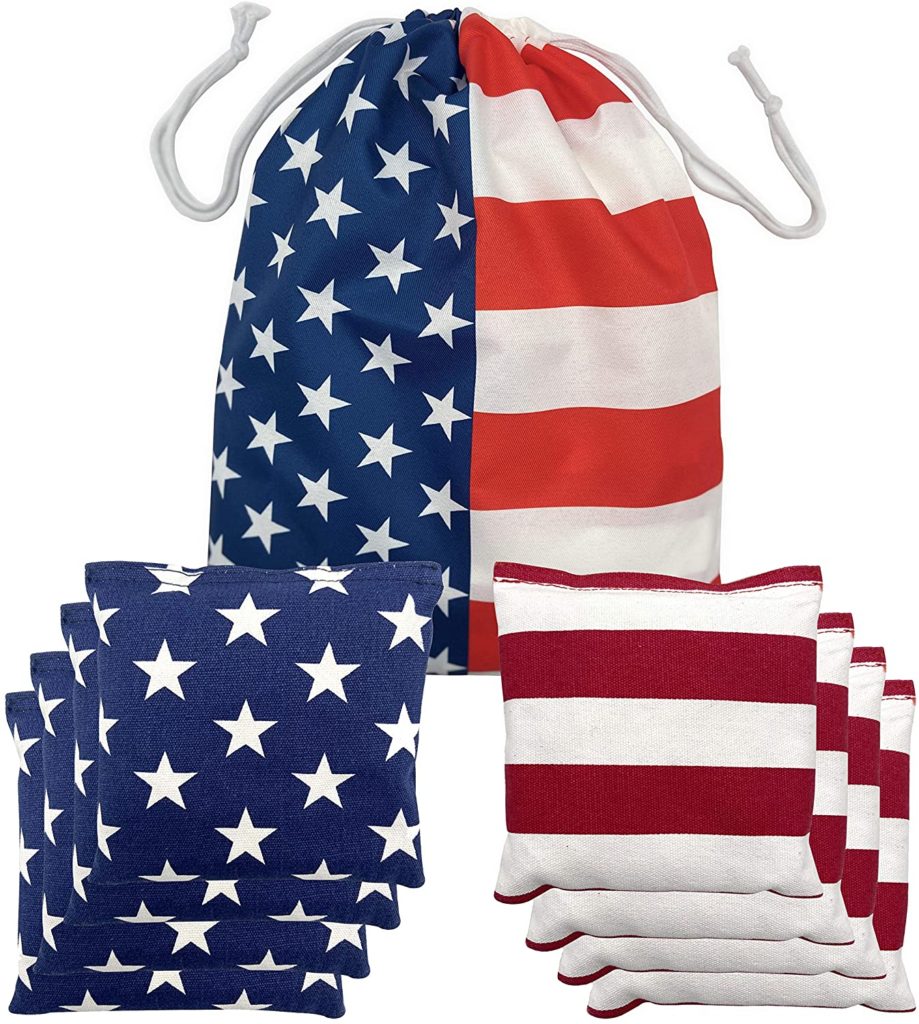
Last but not the least is the Sports Beats cornhole bags, which aren’t exactly a complete cornhole set as it doesn’t come with a game board, but we’re adding it to this list nonetheless because the bags are just so great, perhaps even better than some of the included cornhole bags on the full sets we reviewed above.
That’s because these bags are made with duck cloth fabric that is durable and tough, and made even stronger and long lasting with its double stitched construction. As a matter of fact, these are sturdy enough for playing on concrete, gravel, and grass.
Plus, rather than corn kernels, these bags are filled to the brim with lots of river sand, so they’re water and weather resistant. Meaning, you can play cornhole anytime, anywhere, under any weather condition.
- 8pcs 6×6” all-weather bags
- Regulation 15-16 oz weight
- Comes with tote bag for storage
- Free replacement guarantee
Cornhole History
If you want to know more about this amazing game, here’s a little bit of cornhole history.
The first cornhole game was invented (and patented) in 1883 by Heyliger de Windt, a New Yorker who concocted the game that was then called Parlor Quoits by using a slanted board with a circular hole to serve as a bean bag toss target.
The rights to this patent was eventually sold to a game manufacturer in Massachusetts, who then marketed the game under the name of Faba Baga. This one came with a twist of having two different holes with corresponding point values, as well as an extra bag per team with twice as much points’ worth than the rest.
Cornhole as we know it today, however, was popularized in the early 2000’s by different organizations by hosting tournaments. These include the American Cornhole Association (ACA), American Cornhole Organization (ACO), and the American Cornhole League (ACL).
You can check their official websites here:
American Cornhole Organization
Origin of the Term ‘cornhole’
The origin of the term “cornhole” to refer to this bean bag toss game is actually unclear. Faba Baga was the commonly used name at the beginning, up until interest in the game dwindled and fell off.
As the years went by, the rules of today’s cornhole game popped up, with the game itself going by a few different names largely dependent on the game play’s location. Some of the more popular names include Baggo, Corn Toss, Bag Board, Bean Toss, Bean Bag, Dummy Boards, Indiana Horseshoes, and Soft Horseshoes.
The term cornhole was first used sometime in the 90’s, and it’s attributed to the use of bags of corn as pitching bags.
Cornhole Terminology
There are certain words used in the cornhole game lingo that regular players have taken to using. You might or might not see these terms in rule books and in guidelines from organizations and websites such as the playcornhole.org by the ACA, but it’s best to be aware of these terms as you will likely encounter them when playing.
These include:
- Ace- also called woody, refers to bags that land on the board and score 1 point
- Airmail- straight shots where the bag lands directly inside the hole without first touching the cornhole board
- Back door- an airmail shot or a bouncing shot that lands in the hole despite an opponent’s bag blocking the way
- Backstop- bags that land and finish on the board’s back edge and act as a backstop for subsequent tosses in the current inning
- Blocker- bags that surround or are in line with the hole and prevent other bags from sliding up into the hole (blockers can be knocked into the hole by other bags to score three points)
- Cornhole- a three pointer for throwing the bag into the hole, also the name of the game
- Dirty bag- also called foul, refers to bags that hit the ground and bounce up before finishing on the board, or bags that slide off the board and somewhat touch the ground
- Fault- also called foul or rule violation, is when a player steps over his foul line while the bag is still in the air (in this case, no point is awarded regardless of the bag’s end position)
- Flop- a flat thrown bag with no rotation or spin during its flight
- Frisbee- a powerful throwing style that helps the bag lie flat in the air as it spins similar to a frisbee, in which case the bag has a better chance of staying on the board after it lands
- Hammer- the final bag tossed during any specific inning
- Hanger- also called a leaner, a specific situation wherein the tossed bag lands primarily on the board but a part of it leans over the corn hole, in which case the bag is only worth a single point since it hasn’t fully entered the hole
- Honors- the privilege of making the first pitch in the succeeding inning from where the team or player won the previous inning
- Push bag- refers to a pitched bag that pushes one or more bags that are already resting on the board (referred to as blockers) right into the hole, wherein each knocked blocker bag is worth three points
- Skunk- an optional playing rule wherein whichever team starts the next inning with an 11-0 lead (called a skunk score) automatically wins and the game is concluded
- Slider- bags that land on the middle or the front of the cornhole board, then slides up into the hole
Summary
To sum it up, cornhole is a fun and exciting outdoor game that kids and adults alike can play for hours of competitive entertainment. It’s a breath of fresh air from staple indoor games such as PacMan on cocktail arcade tables, or a game of pool on your air hockey pool ping pong combo table. And, it’s a little more physical than a simple hook and ring toss game.
There you have it! We hope you learned everything you need to know about cornhole, or even managed to find a suitable game set for you and your loved ones to play with. Just don’t forget the helpful tips and tricks we shared so you can earn those points quickly!
Want to play a different game? Here’s a beginners’ guide on everything you need to know about billiards or pool, including how to hold a pool stick.






